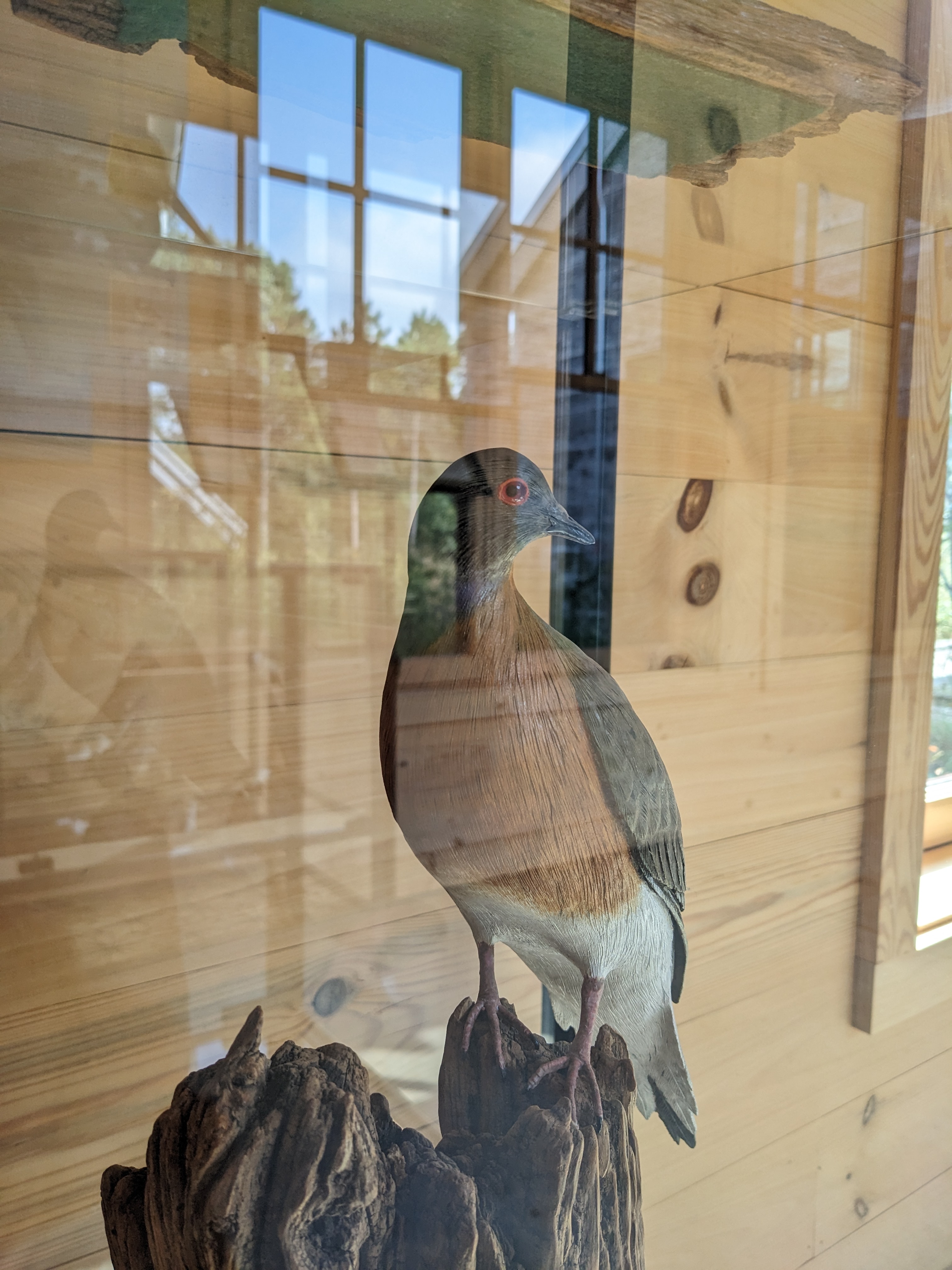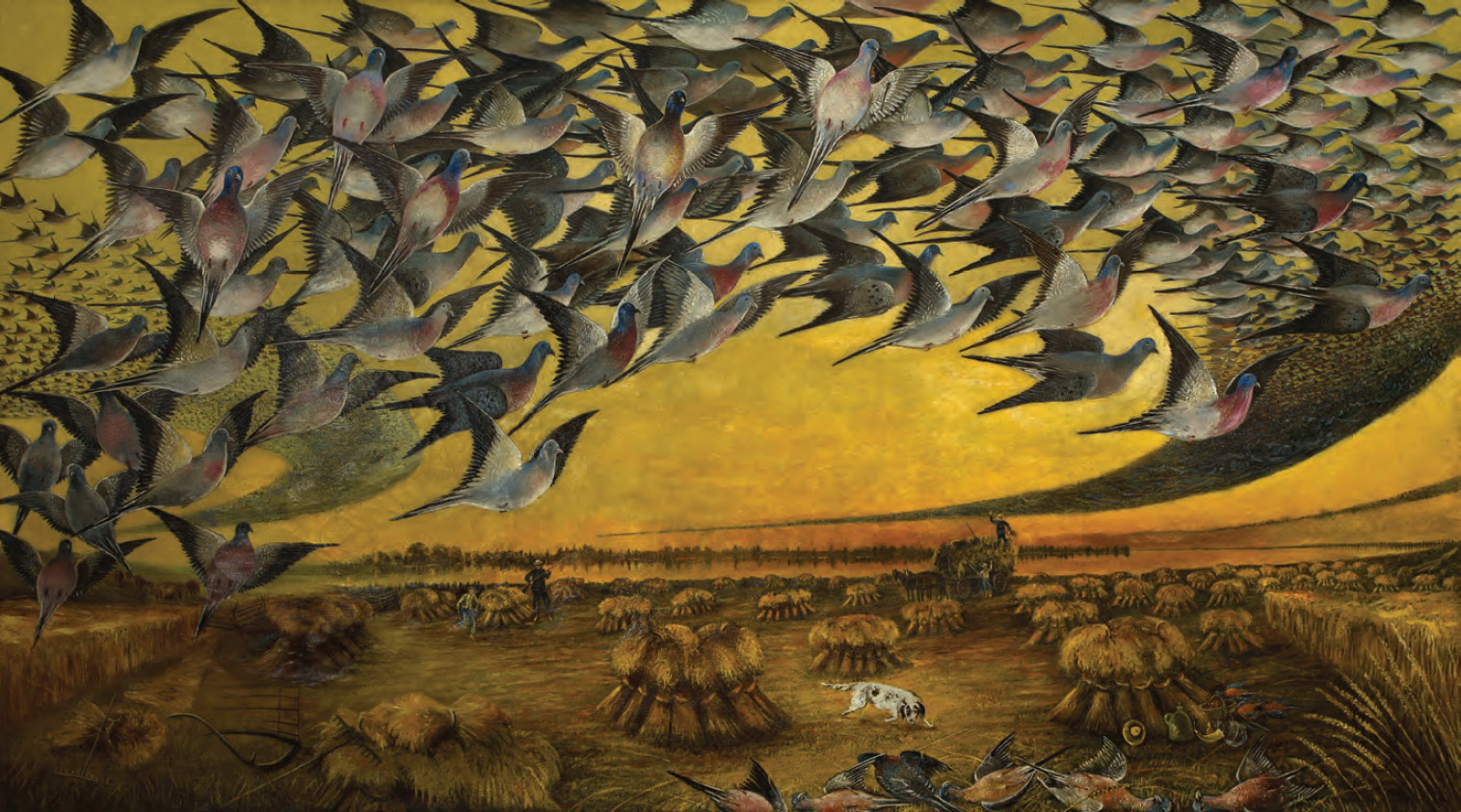Nature needs YOUR land ethic!
Stay connected through our down-to-earth e-news.
.png)
.png)

Every day, I make a point of getting up from my desk and going for a walk. The oak savanna loop just outside the visitor center is the ideal length for a fifteen-minute break, a chance not only to stretch my legs and get some fresh air, but to check in with the biotic community just outside the door. How do you do, goldenrod? Oh, hi there, grasshoppers! Is that our sweet little redheaded woodpecker I hear in the trees? I take note of the weather, the rustling in the underbrush, the flitting of bird or butterfly across the trail. How the ground goes from stiff grass to soft sand and pine needles. If any mosquitoes have managed to get under the head net and bite my face.
On my way back into the building, doing the obligatory scan of my pant legs for ticks, I notice, as I often do, the art display. Down the visitor center’s thermal-flux hallway, you’ll find two glass cases with wood-carved birds inside. These beautiful effigies were crafted by Alan Bennett, a talented artist and woodworker with a background in wildlife biology who also serves as a tour guide with the foundation. Accompanying the carvings, two wall signs identify and describe the different bird species, with Leopold quotes paired to each. Chickadees and woodcocks, favorites from A Sand County Almanac; grouse, wood ducks, bitterns. Poignantly, there are passenger pigeons, who were already extinct when Aldo wrote his “On a Monument to the Pigeon.”
It’s a sad and sobering thought, whether you’re Leopold penning the words in the 1940s or an Aldo Leopold Foundation employee reading them in 2025. Is immortality worth that, I wonder. The train of thought somehow leads me to the notion of uploading our human consciousness to the cloud. In that scenario, too, you could live forever—yet feel nothing.
~
Hold on a second—what in the world am I talking about, uploading our consciousness?
If it sounds like some crazy sci fi thing, that’s because it is—mostly. “Mind uploading” describes the potential of transferring human consciousness from the brain to a digital medium, like a supercomputer or a cloud server. Whether by precisely replicating the entire connectome (86 billion neurons and 100 trillion synapses) digitally or scanning the brain slice by slice and copying its contents—the details remain to be worked out—scientists could theoretically preserve the mind indefinitely. Our memories, thoughts, experiences, dreams; a virtual consciousness apart from the body. Through mind uploading, humans might achieve a digital immortality.
Once entirely theoretical (fantastical, even), some scientists allege that the possibility is closer than ever, based on current and projected advancements in technology—especially with machine learning and artificial intelligence. It could perhaps be a reality within the next 100 years or so.

The prospect opens up a Pandora’s box of ethical, philosophical, and logistical questions. Would the transferred cloud consciousness actually be you, or just a copy that thinks it’s you? Can such a process be democratized and made accessible to everyone? If not, what are the socio-cultural implications if only certain people “live forever”? What about privacy and ownership of our mind data in the digital sphere? Who or what powers the supercomputers and data processing centers, and what are the environmental impacts? Could someone flip a switch and shut off your consciousness against your will?
Discussing any one of these questions in isolation could be its own book, but what I aim to explore here is this: is mind uploading a form of escapism? That is, by “going digital,” would we be running away from an earth imperiled by human action, extraction, and degradation? Fleeing a world that’s increasingly unlivable and unlike what we once knew?
This escapism has an appeal. Flight is one of our primary survival strategies, after all; culturally, we gravitate to stories of getting away from danger and destruction and finding refuge elsewhere. Was the Leopold family’s Shack experiment not such an escape—from the hustle and bustle of commercialism, development, mechanization? The loss of nature elsewhere? Was it not rooted in the desire to flee the unpleasant, what they couldn’t control?
But the directionality of the Leopolds’ “escape” was clearly different. Aldo and his family aimed to “go back” to something primeval, something at the roots of our human evolution that had been left behind to create our modern lives—at least, in the Western world. The consciousness-uploaders, on the other hand, seek to go forward, push technology further into as-yet-unknown possibilities, to do something brand new.
In another sense, though, the Shack experiment wasn’t an escape at all. Described in the foreword to the Almanac as a “refuge from too much modernity,” the Shack allowed the Leopold family to reconnect to the broader land community. With every weekend getaway, every vacation, they made the time to check in with their biotic relatives. Look, the geese have returned after the winter! Tiny Draba is blooming on the sand blow. The river has risen with thaw, flooding the road—guess we’re stuck here a while. To acknowledge not just the human connection to the land, but the human belonging within the land community, is the furthest thing from escape. It’s the ultimate act of grounding in and commitment to the now.
.png)
Mind uploading, in contrast, seeks to transcend the limits of the human body and mortality itself—with its sickness and death, its “lash of wind and weather.” While a digital consciousness could be transferred into an artificial body—or even between multiple artificial bodies over time—to allow movement through the real world, it could also carry out an entirely digital existence, inhabiting simulated worlds and virtual reality. But beyond these cyberpunk-esque possibilities, mind uploading could provide real relief, access, and hope to those afflicted by degenerative disease, terminal illness, or neurological disorders, offering, as an article from Infinous.org puts it, “the ability to preserve the self independent of the decaying biological substrate. When one’s memories, thoughts, and personality can be captured and migrated to a more stable and maintainable medium, suffering no longer has to be the terminal endpoint of human identity.” It’s hard to argue with the medical promise it might provide to so many.
However, some scientists and philosophers question whether consciousness can even exist apart from an organic, living body. In his article “Understanding Mind Uploading,” Samuel Esteva sums up the arguments of cognitive philosopher Massimiliano Cappuccio this way, writing that “…consciousness is inherently embodied. The body’s physical structure—its sensory inputs, movements, emotions, and biological rhythms—are not just accessories to thought; they are part of the thinking itself” (emphasis added). This makes an intuitive kind of sense, at least to me: so much of what we’re conscious of comes from our bodies. The internal states of hunger and pain; the sensation of cool breeze or searing sun on the skin; the experience of sitting or standing or walking; what we’re looking at, listening to, tasting. These things shape not just what we think about, but how we think, in many ways.
If the body is integral to our conscious experience, then couldn’t the same be said for the land—the realm our bodies inhabit? Its waters, soils, plants, fungi, and animals are not just the backdrop to our existence, but part of—nay, essential to—existence itself? We have to belong somewhere. Can we really live in a vacuum, with no ties to the natural environment? Can a simulated landscape ever replace messy, unpredictable, living organisms—our evolutionary kin, whom we interact with, depend on, and forge our lives alongside?
Furthermore, what of our responsibility to the land? It’s all fine and dandy to convert your thoughts to binary code and slip away into an eternal virtual reality (assuming it were that easy), but what of the very real world you leave behind in the process? The species we’ve endangered, who can now only recover with our help? Landscapes that require human care, physical and emotional, to thrive? Does our digital disappearance feed into the idea that humans are bad for the earth, and the best thing we can do is leave it alone—while simultaneously implying that we’re too good for the earth, superior to all else on it, and thereby worthy of special treatment?
~
It’s easy—and tempting—to assume what Leopold might have thought. We can usually only guess from what he wrote, extrapolating to things he never could have imagined in his lifetime. It’s a tricky exercise.
However, I found a surprising tidbit in my research.

The “On a Monument to the Pigeon” essay was originally drafted as a speech, which Leopold gave at the 1946 convention of the Wisconsin Society for Ornithology. The version we know today from A Sand County Almanac was edited, removing what Dr. Stan Temple refers to as a “tirade” against science and technology, where Aldo—among other things—said this:
Time was when the aim of science was to understand the world, and to learn how man may live in harmony with it…. But science, as now decanted for public consumption, is mainly a race for power. Science has no respect for the land as a community of organisms, no concept of man as a fellow-passenger in the odyssey of evolution. Science has developed a kind of cosmic arrogance...
In light of these remarks, it seems quite likely, if not certain, that Aldo would vehemently reject the techno-transcendence of mind uploading.
There’s the murky question of the intentions behind the science. Is it technological advancement for the sake of advancement—a self-serving “cosmic arrogance”—or is it truly to understand the world and better our relationships therein? Even in the best-case scenario, what place does the land community have in the digital plane? Besides that, Leopold would surely detest simulated goose music, or computer-generated pasque flowers, or a virtual “wilderness.” And even if our digital minds came back to earth from time to time in robot bodies or what-have-you, the experience of being a human—flesh and bone and everything that entails—amongst our evolutionary fellows would be lost.
As Aldo insinuated in the Monument essay, our existence is inextricable from the land. An extinct species can be preserved in taxidermy, in sculpture, in artwork, in photographs; in documentaries and books; in oral tradition and memory; hell, even in virtual reality; but without a living, breathing connection to the land, that’s not life.
Someday soon, humans might be able to move their minds to the digital sphere, transfer thoughts as data, upload and download memories, update continually to the latest software, be “conscious” forever in a computer, but without true connection to the land—whether planting pines by the thousands as a long-term restoration project or walking among them as a daily act of self-restoration—can we really call that life? And do we want to live it?
I’ll leave off with one final Leopold quote, a portrait of the earthen dependence we all share—pigeons and people alike.
~~

The Aldo Leopold Foundation was founded in 1982 with a mission to foster the Land Ethic® through the legacy of Aldo Leopold, awakening an ecological conscience in people throughout the world.
"Land Ethic®" is a registered service mark of the Aldo Leopold Foundation, to protect against egregious and/or profane use.
Stay connected through our down-to-earth e-news.